“A leader’s most important job is creating and constantly adjusting the strategic bridge between goals and objectives.” - Richard P. Rumelt
Table of Content
- Overview
- The correlation between goals and objectives
- What are business objectives?
- How to set business objectives in 3 simple steps
- SMART Objectives
- 100+ business objectives examples
- Business objectives pertaining to human resources and recruitment
- Business objectives pertaining to customer relationship
- Business objectives related to finance
- Business objectives related to marketing
- Business objectives pertaining to sustainability
- Business objectives related to innovation
- Business objectives related to learning and development of employees
- Business objectives pertaining to performance management
- Business objectives related to production and operations
Overview
No organization likes to be complacent or stagnant in terms of its growth and expansion. With ambitious leaders at the helm of things, organizations have their eyes on mammoth growth to establish themselves at the global pedestal. If you ask startup owners what their most salient entrepreneurial dream is, most of them would say that they want their business to be on the list of Fortune 500 companies one fine day. But what do you think is the core prerequisite for taking a business to new heights?
Of course, it is the effectiveness of a company’s strategic planning and how it goes about its business objectives that are inspired by its meticulous strategies. In this thoughtful blog, we elucidate the concept of business objectives and also put forth the most effective steps for formulating business objectives along with pragmatic examples. So, let’s get started with discovering the relationship between goals and objectives first.
The correlation between goals and objectives
"Setting goals is the first step in turning the invisible into the visible” - Tony Robbins
Goals and objectives are sacrosanct for individuals, communities as well as business organizations. Positive changes come into existence when imperative objectives are met and no matter how much the world changes in the coming years, this fact remains immortal. Objectives are the stairs that an individual or organization takes to reach new heights of success. It is not the imagination of success that makes you successful but your path to success has to be facilitated by objectives at every step.
The bottom line is that you cannot move to the next objective before you attain success in your current endeavor. It is the amalgamation of multifarious short-term and long-term objectives that leads an individual to success. The same is the case for business organizations. But is there a difference between the goals and objectives of a business organization? Well, there certainly is a striking difference!
The goals of a company define the horizons it wants to scale and where it sees itself in the next set of years. Objectives on the other hand define the ways in which a company can reach those heights. While goals are about the destination, objectives are the pathways to it and in the business world, these objectives are often discrete and measurable.
Besides, while strategic goals speak for business strategies and the visualization of new facades of success, objectives revolve around the numbers, indicators, and deadlines imperative to these goals. To sum it up in a simple way, business objectives are subsets of strategic goals. Furthermore, let us now glance at the definition of business objectives.
What are business objectives?
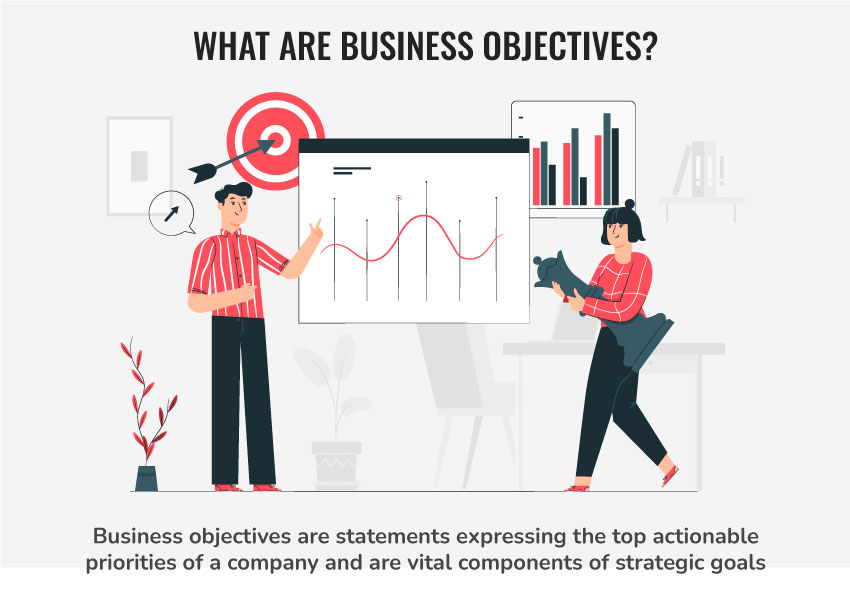
Every company has its unique vision and mission statements that act as a constant source of inspiration for everyone associated with it. Moreover, these statements are constant reminders of the position and status that a company wants to acquire in the near future. For Instance, let us look at the mission statement of Elon Musk’s SpaceX. Its mission statement expresses its ambition to revolutionize the fundamentals of space technology and to enable people to live on other planets.
Woah! Now that is one of the most fascinating and ambitious mission statements ever, isn’t it? But how do you think Elon Musk is going to turn this vision into a functional reality? The answer lies in strategic objectives or business objectives. For SpaceX to reach its ultimate destination, it has to accomplish a wide spectrum of strategic objectives in a given time frame.
Coming to the definition of business objectives, let us delve into a comprehensive explanation of the concept. The business objectives or strategic objectives of an organization are planned and structured statements that express the top actionable priorities of the organization’s strategies. To put it the other way around, business objectives are elements of the most quintessential strategic goals that a company has. Of course, these strategic goals have a vision to them, and that same vision serves as the inspiration for business objectives across various domains.
Moving forward, these are the objectives that a company looks forward to achieving in the next three to five years as a culmination of umpteen short-term objectives. As mentioned earlier, these specific objectives are measurable and crucial in terms of evaluating the performance and progression of strategic goals within an organization. The assessment of business objectives determines if a company is on the right track to accomplishing its strategic plans.
Furthermore, when you decipher the strategy versus tactics relationship, you can very well understand that strategies and strategic objectives are always long-term. In the usual sense, a strategy is not something that works in a day or a week. Any strategy and its linked strategic objectives are concerned with the larger picture that looks at massive overhauls and transformations.
Probing further, strategic business objectives relate to the most crucial factors and verticals of business success that include productivity, profitability, revenue growth, operating costs, market penetration etcetera. Furthermore, as mentioned above in the context of the SpaceX example, business objectives are directly correlated with the mission and vision of a company.
What is important to understand here is that we need not generalize business objectives. These business objectives are subject to vary largely from one industry to another and in fact, even across departments in an organization. To augment, in any organization, business objectives are the ambitions that are unique to every strategic goal. For instance, the business objectives of a company’s product design strategy will be completely different from the same company’s marketing strategy. Similarly, the business objectives related to finance will significantly vary from business objectives linked to customer service.
In the ultimate sense, what matters the most is the efficacy with which a business identifies the need for specific goals to be met over a period of time, sets its objectives, and does every little thing right to accomplish its business objectives. When business objectives are met with the desired objectives, strategic planning succeeds, and businesses advance. Speaking of effective practices for setting business objectives, the subsequent section sheds light on the simplest steps for the same.
How to set business objectives in 3 simple steps
In the corporate world, what sets the most successful companies apart is that they do not set their strategic business objectives on assumptions, instincts, or overwhelming emotions. For them, every business objective is inspired by extensive strategic planning taking into consideration a plethora of crucial factors. These factors also correlate with the core competencies of the business and the available capital and human resources.
The key is to choose the most appropriate approach from the spectrum of strategic planning models and apply it in an effective way to define the course for strategic objectives. Organizations will need to apply different planning models for different goals and keep innovation at the forefront.
The following steps present a simple yet highly efficient framework based on which companies can set their business objectives to drive positive outcomes and greater success. However, setting business objectives is only half the job done. Eventually, it is the execution of tactics applied for the accomplishment of these business objectives that make the real difference.
Drawing purpose from values, vision, and mission
If the values, vision, and mission of an organization are leaning towards the west, business objectives cannot be racing towards the right, isn’t it? Business objectives need to derive their purpose and outlines from the vision and mission of the company. Moreover, each business has a set of core values that it does not compromise with at any cost. Every business has its unique spectrum of virtues and principles and these virtues set a guideline for everything that happens within an organization. Having said that, when you set business objectives for your organization, you definitely need to take the core values and vision of your business into consideration.
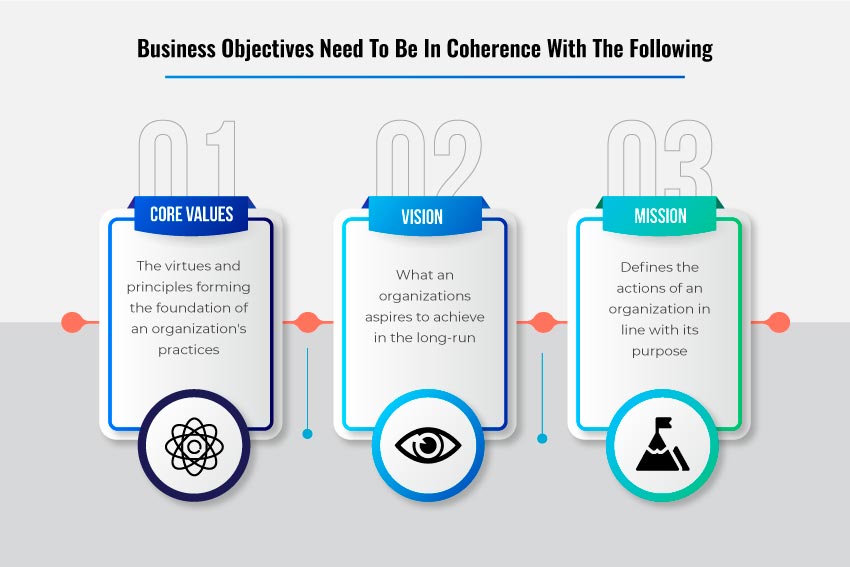
Therefore, every strategic goal has to be aligned to the vision, mission, and values of a company. Having defined clear strategic goals that correlate to the above fundamentals, the business objectives should then be set. To exemplify, as per the official website of Woolworths Group, sustainability is an intrinsic core value for the company. Based on this core value, the company has set a strategic goal for itself as a part of its Sustainability Plan 2025. As you can see, it is a long-term strategic goal that Woolworths aspires to accomplish in the next three to four years. Consequently, under this strategic goal, the company has set the following business objectives for itself.
- Switching to green electricity
- Significant reductions in carbon emissions
- Bringing down the volume of food waste going into landfills
- Making investments in employee wellness
- Indulging in recyclable packaging practices
This example of Woolworths explains that one of the most worthwhile approaches to setting business objectives is to link strategic goals to virtues, vision, and mission. Thereafter, the strategic goals can be further divided into multifaceted objectives reflecting the same values. In this way, business objectives will be consistent with what an organization represents and wants to be known for.
Make use of the ACES approach for setting business objectives
The next step after realizing the purpose of business objectives is to implement an ACES approach. What is an ACES approach but? Well, ACES stands for the following parameters crucial for setting business objectives.
- A: Achieve
- C: Conserve
- E: Eliminate
- S: Steer Clear
Here, Achieve signifies what a company wants to accomplish in the future corresponding to a time frame in sight. Furthermore, Conserve is about the aspects and dimensions of functioning that a business wants to preserve even in the future given the promising returns on them. To add, Eliminate signifies the practices, expenses, or risks that a company wants to get rid of so that it can meet its strategic goals with greater ease and efficiency. At last, Steer Clear denotes the possibilities of negative outcomes that a company does not want to be vulnerable to.
Hence, business leaders and the top management of an organization should work on a comprehensive ACES analysis while setting business objectives. Business objectives will have the maximum clarity and impact when there is a clear understanding of the dimensions of the ACES approach in the minds of the leaders at the helm of an organization.
Let us take the example of a diversification strategy in business here in correlation with an ACES outlook. As we know, product diversification is one of the common strategies undertaken by businesses to grow at a rampant pace, enhance their profitability and attain greater success. Under this strategy, companies launch new product lines to grow bigger and better. So, when a company starts working on strategies for product diversification, the ACES will come into the picture in the manner given below.
A: The company would want to achieve higher revenues with an expanded product line and win new customers by entering new markets. This will enable the company to diversify its profits and have multiple streams of revenue while reducing competition. How Elon Musk decided to venture into space exploration with the launch of SpaceX after attaining handsome success with Tesla is a fine example of such diversification.
C: Even after the launch of SpaceX leading to shifting focus and increased workload, Elon Musk would want to conserve the competitive positioning of Tesla and the constant R&D for innovation. Elon Musk will be more than interested in diversifying the Tesla product portfolio as well.
E: Elimination of additional and avoidable costs will be another crucial factor for diversification within Tesla and SpaceX. In fact, last year Elon Musk announced that Tesla is keen on slashing the costs of battery production to bring a new product line into the electric car market that will cost USD 25000.
S: Any company would want to stay clear of any undue risks or competitive disadvantages. As we know, SpaceX and NASA are working together on several projects and NASA’s support is a massive boost for SpaceX to meet its ambitions of dominating outer space. Having said that, as a part of his diversification and growth strategies, Elon Musk would look to steer clear of any disputes or contradictions with NASA or the US government.
Use KPIs to set measurable business objectives
In the best interest of strategic goals, it is imperative that business leaders set objectives that can be measured. For that, it is crucial to deliberate on various performance indicators that can evaluate objectives. Having said that, key performance indicators need to be set simultaneously while defining business objectives under strategic goals. While business objectives will define how strategic goals can be achieved, the KPIs will define the parameters on which the objectives will be measured.
Simply put, key performance indicators will quantify the success and progression of the business objectives. This will ensure that the top management will have access to quantifiable insights at all times to see if the fulfillment of objectives is aligned with the set deadline. In fact, that is what the true essence of objectives is! Strategic objectives are meant to be measurable to evaluate the performance and progress of strategies undertaken by companies. Having said that, KPIs make quantifiable evaluations feasible by adding certain metrics to business objectives.
For instance, let’s say a business is working on the strategic goal of building a strong internet presence with the help of the best in class digital marketing practices. Subsequently, let’s say enhancing Search Engine Optimization (SEO) tactics is one of the pivotal objectives that marketers realize as a part of their strategic goal. Now, while setting this business objective, some key performance indicators also need to be identified so that those in the digital marketing team know exactly what is expected of them. Listed below are some of the KPIs that can be identified while setting objectives around SEO.
- Number of backlinks
- Bounce Rate
- Leads and conversions
- Ranking on target keywords
- Pages per session
- Page load time
- Organic traffic
- Branded traffic
- Non branded traffic
- Click-through rate (CTR)
The bottom line is that objectives and key performance indicators to measure them are complementary to each other. Having said that, the golden rule for setting business objectives is to define the KPIs that will be used to evaluate the objectives. Eventually, both objectives and KPIs should be conveyed to everyone as a part of strategic communications within the organization.
The subsequent section highlights the concept of SMART business objectives, their relevance, and imperativeness for business success.
SMART Objectives
SMART objectives divide business objectives across five dimensions that include the following.
- S: Specific
- M: Measurable
- A: Attainable
- R: Relevant
- T: Time-Based
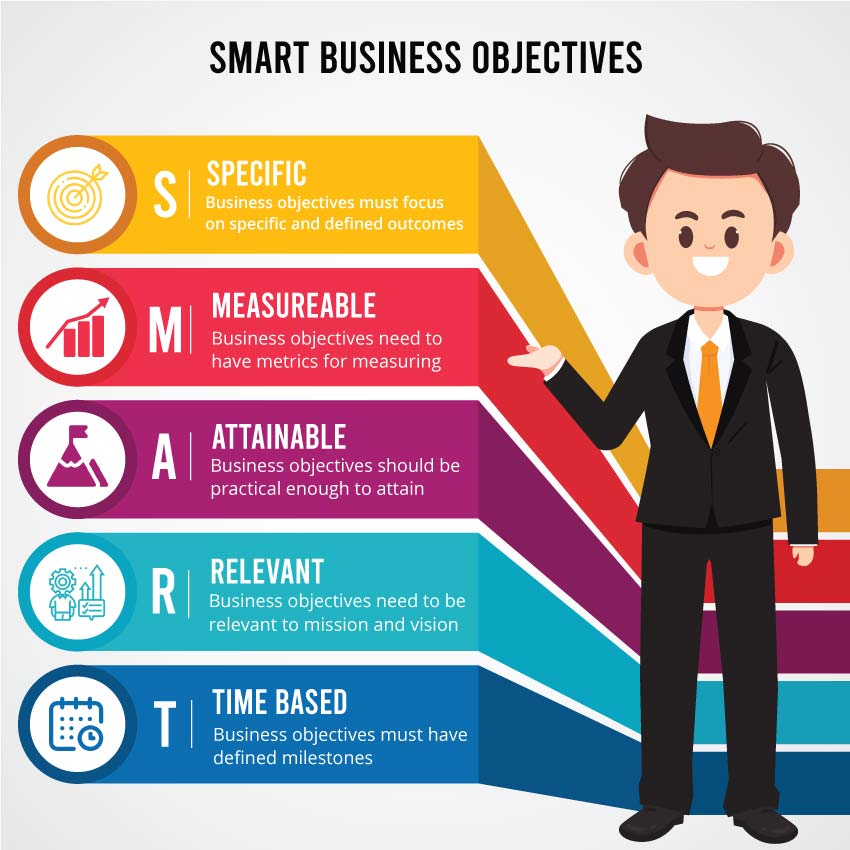
The purpose of SMART business objectives is to identify and set objectives that are backed by thoughtful and intelligible planning, clarity of purpose, and scope for tracking. Needless to say, well-structured business objectives seem far more feasible and hassle-free than vague objectives lacking direction, isn’t it? Having said that, the best way to set business objectives for your company is to settle for nothing less than SMART objectives. Let us further delve deeper into the breakdown of SMART goals to decipher the relevance and advantages better.
Specific: Every business objective should have a specific purpose and should look to target a specific outcome. The fact of the matter is that business objectives work the best when they are narrowed down to discrete domains of business operations. The more specific they are, the more effective will be the execution with a distinct aim in mind. Moreover, the specific nature of objectives will also ensure that the teams are able to effectively understand the best practices for delivering on the business objective. To add, the best possible KPIs can only be recognized when an objective is clear and specific.
To exemplify, under its market penetration strategy if a company wants to emerge as a cost leader, it is a specific business objective linked to the idea of growth and advancement.
Measurable: This is something we have been emphasizing time and again in the above sections. The most impactful business objectives that can trigger real changes are the ones that are measurable. Setting milestones for business objectives and defining relevant KPIs to establish parameters for assessing progress is sacrosanct. Having said that, business objectives should be made as measurable as possible for evaluation and reevaluation.
To exemplify, If a pharmaceutical company has set an objective of increasing its market share through mergers, there have to be some metrics associated with this objective. Having said that, the percentage of market share the company is looking to attain after mergers is a measurable goal. Let’s say the company’s present market share is 12 percent and the company wants to increase it to 23 percent. So, the measurable business objective is to enter a merger agreement with a company that holds 11 percent of the market share.
Attainable: If the goals set by a business organization are achievable in the real world or not is a massive consideration. There is a decent amount of experience, credentials, and skills that go into setting business objectives. Leaders should make sure that they leverage these resources to set attainable business objectives. Overwhelming ambitions need to be kept aside and critical analysis needs to be done before setting business objectives. The purpose of this critical and careful analysis is to determine if a company can actually achieve a business objective in the stipulated time frame.
To exemplify, under the strategic bid to double the sales of automobiles in the next three to four years if a company sets the goal of increasing sales by 5 percent in the next quarter, it is an attainable objective. On the other hand, if a company sets the objective of increasing the sales by 50 percent in the next quarter, that is merely an ambition without any planning, critical thinking, and vision.
Relevant: Business objectives need to be relevant and cohesive to the unique values and long-term strategies of the company. Any objective that is in contradiction of the mission and long-term strategies of the company can create unnecessary chaos and confusion. Having said that, a smart objective is one that is inspired by and aligned to the core virtues and future strategies of the company.
To exemplify, for a vegan brand, investing money in robust research and development for identifying new sources of plant protein will be highly relevant. On the other hand, any sort of research undertaken on animal protein will be completely irrelevant and would make no sense.
Time-Based: Important business objectives come with deadlines and that is exactly how they should be. There should be a time frame associated with every business objective that shall clearly lay out the deadlines. Deadlines or milestones will give employees or teams a clear idea of how urgent an objective is and what needs to be the pace of workflow management. They will know that they need to meet all the small-term goals on time to make sure that the long-term business objectives are accomplished as per designated deadlines. Hence, in addition to KPIs measuring performance, the objectives also need to be time-based with clearly demarcated deadlines.
To exemplify, if a company’s objective is to cut down its carbon emissions by 25 percent, there has to be a deadline in place as well. The company can commit to cutting back on its carbon footprint by 25 percent in the course of 2 years. In this way, the top management and employees will have a clear idea of how much they need to increase their dependence on green energy and cut back on their carbon footprint every quarter. A deadline establishes complete transparency, fixes accountability, and motivates employees.
In the upcoming section, let us glance at hundreds of more examples of business objectives across different verticals of business functioning and operations.
100+ business objectives examples
Since we asserted above that business objectives need to be specific, we have classified these examples into different categories as per verticals of an organization’s functioning.
Business objectives pertaining to human resources and recruitment
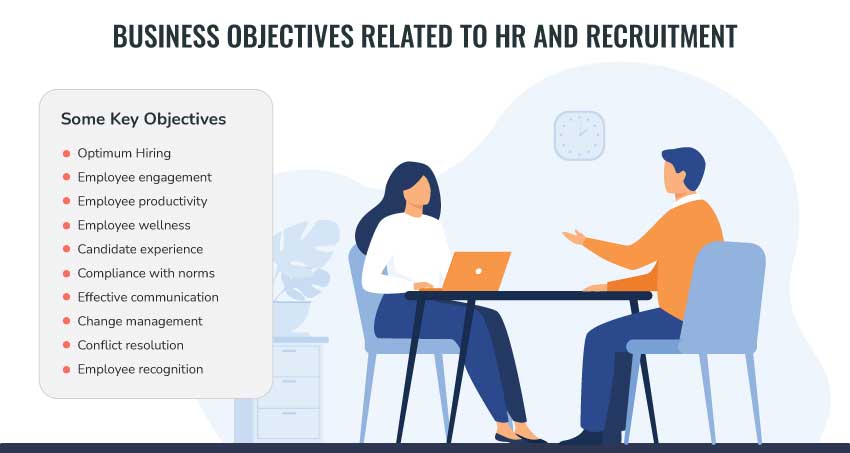
1. Hiring the best fits for the organization
It is the responsibility of the HR managers to screen candidates for qualifications and relevant employability skills. They need to be sure that they are hiring the best fit for the organization.
Key tip: One great way of hiring the most skilled and best-suited employees is to list job vacancies on global job websites like Glassdoor, Indeed, Upwork and so on that have networks of the best professionals from across the globe.
2. Driving higher employee engagement
As per Gallup, high employee engagement can lead to 22 percent higher profitability. Having said that, HR managers need to drive higher engagement through worthwhile ideas and activities.
Key tip: One fabulous way of driving higher employee engagement is to offer flexibility and remote working arrangements to employees
3. Promoting diversity and inclusion in the workplace
The morale and comfort of employees remain high in a workplace that embraces diversity and pluralism. Hence, HR managers need to ensure that the organization delivers on the same.
Key tip: Including everyone in the decision-making processes within the organization and seeking the opinions of all employees on various matters is a great way to promote pluralism.
4. Creating a positive organizational culture
As per Forbes, strong company cultures can help a company increase its revenues by 4 times. Besides, millennials and Gen Y workers choose organizations based on their working cultures.
Key tip: Fostering the virtues of empathy and positive relationships between colleagues can be the key to establishing a positive workplace environment.
5. Resolving workplace conflicts
Conflicts between employees can lead to mistrust and project failures. HR managers need to ensure that they identify workplace conflicts and resolve them at the earliest.
Key tip: Identifying the vulnerabilities and possibilities of conflicts in the workplace and addressing them before they grow big is a perfect solution to keeping conflicts at bay.
6. Creating positive candidate experiences
Irrespective of whether a candidate is selected or not, creating positive candidate experiences is quintessential for a company’s reputation in terms of attracting top talents.
Key tip: Enquiring about the well-being of candidates and their family members in grim times like the COVID-19 havoc can be an amazing way to create positive candidate experiences.
7. Ensuring compliance with company norms
It is the prerogative of the HR managers and professionals to keep a check on employees with the purpose of ensuring compliance with company norms at all times.
Key tip: Communicating the compliance norms and other regulations related to the organization and work during onboarding training can be a great idea to achieve this objective.
8. Keeping absenteeism in check
High rates of absenteeism can affect an organization’s efficiency in multiple ways. Hence, one of the key objectives of HR professionals is to keep absenteeism low by addressing related reasons.
Key tip: Setting disciplinary norms in place and conveying repercussions of high absenteeism to employees can be a worthwhile approach to reduce employee absenteeism.
9. Facilitating effective change management
From the increasing prevalence of highly paid freelance jobs to the increasing dependence on automation, the business world is undergoing massive transformations. HR managers need to support employees to be comfortable around these changes.
Key tip: Continuous feedback sharing and reviews on performance are among the top strategies for effective change management within an organization.
10. Assisting employees in burnout situations
Employee burnout is a common phenomenon in the contemporary corporate world hence affecting individual as well as organizational productivity. HR managers need to assist employees to deal with burnout conditions.
Key tip: Initiating programs on mental wellness and extending psychological help to employees through different events, webinars and activities will add great value to this pursuit.
11. Fostering work ethics
Leading by example when it comes to professional ethics is a key objective for HR managers. From integrity to accountability, HR managers have to promote multifarious ethics in the workplace.
Key tip: Establishing a code of conduct around workplace ethics and appreciating those who portray ethical behavior in the workplace is a worthwhile way of meeting this objective.
12. Maintaining an effective flow of information
One of the most salient objectives of the human resources vertical is to ensure a worthwhile flow of information between employers and employees. The transparent flow of information is critical to the motivation of employees.
Key tip: Launching internal newsletters and creating multiple channels for digital communication in a remote or hybrid culture can be highly beneficial to the cause of this objective.
13. Ensuring maximum productivity among employees
An imperative objective of the HR department is to work on various strategies and approaches to inspire the best productivity in employees for boosting the overall efficiency of the organization.
Key tip: Conveying clear goals, instructions, and deadlines to employees for every work commitment can be a great way of boosting employee productivity.
14. Reviewing employee recognition and perks
As per HubSpot, 69 percent of employees feel that they will work much harder if they receive genuine recognition. Hence, to facilitate the highest efficiency in employees, HR managers need to supervise employee recognition and perks.
Key tip: Offering innovative and personalized rewards like gym memberships, Netflix subscriptions, sponsored vacations, and so on can be some ideas for recognition to inspire the highest levels of motivation and engagement in employees.
15. Investing in employee experiences
Investing in employee experiences pays off in different ways for an organization ranging from higher retention to a willingness among employees to take up additional responsibilities. Given that, HR managers need to focus on enhancing employee experiences.
Key tip: Launching financial wellness programs to assist employees in financial literacy and to help employees in financial urgencies can be an incredible strategy for creating unparalleled employee experiences.
16. Minimizing time in candidate screening and maximizing efficiency
Every organization wants that the screening of candidates should be efficient and be done in a timely manner. Having said that, minimizing screening time while maximizing the matching of skills is a common recruiting objective.
Key tip: An applicant tracking system can be implemented in recruiting to automate the screening of resumes and to shortlist candidates in a manner faster than ever before.
17. Ensuring quick responses to candidate queries
Another imperative objective linked to recruiting is the elimination of unnecessary delays and communication gaps in passing information to candidates.
Key tip: Setting different criteria for shortlisting candidates that are to be responded to on a priority basis will help recruiters to meet this objective effectively.
18. Implementing AI in recruiting
As AI is driving positive changes in every sphere of life, the corporate world too is making big gains from the prowess of artificial intelligence. The implementation of AI in recruiting is an objective more and more businesses are chasing in concurrent times to refine their recruitment processes. The AI chatbots will also help a great deal in the objective of responding to applicants in a brisk manner.
Key tip: To make the implementation of AI a positive development for the organization, it is important to train recruiters for effective collaboration with AI in recruiting.
19. Mitigating unconscious bias in recruiting
Unconscious bias is quite prevalent in recruitment processes and for hiring the best fits for the organization, the mitigation of such bias becomes a significant objective for businesses.
Key tip: Using skill tests to evaluate candidates and making hiring decisions on the basis of the performance in skill tests can be an effective way to mitigate unconscious bias in recruitment.
Business objectives pertaining to customer relationship
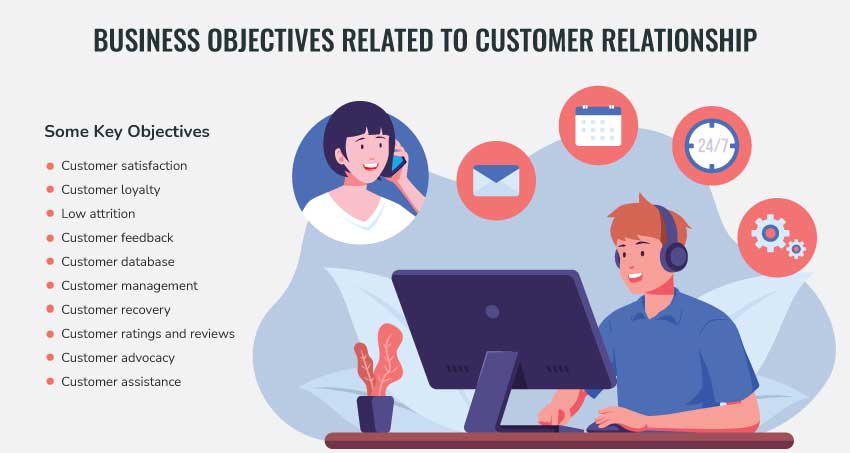
1. Offering excellent customer service
Given the importance of customer retention and changing customer expectations, offering excellent customer service is among the top priorities of businesses. In modern times, customers make purchasing decisions based on their previous experiences in terms of customer service.
Key tip: Creating dedicated channels and teams for catering to customer queries, service complaints, and round-the-clock assistance is one of the most powerful tactics for providing excellent customer service.
2. Enhancing customer satisfaction
In addition to delivering on service perks for new customers, businesses also set the objective of enhancing the satisfaction of their existing customers.
Key tip: Providing products and services onboarding to customers so that they do not face any issues can be the key to driving high customer satisfaction.
3. Upscaling customer loyalty
Winning customer loyalty and bolstering it in a constant way is a crucial objective that every business sets as customer loyalty is the foundation of customer retention and relationship. Loyalty is a key determinant of any relationship and businesses in the same vertical are often seen competing with each other to build greater allegiance among customers.
Key tip: One of the smartest ways to enhance customer loyalty is to design thoughtful and lucrative customer loyalty programs that offer special privileges and rewards to customers on repeated purchases.
4. Decreasing customer attrition
Every customer lost by a company will eventually translate into a loss in revenue. Hence, working on ways to minimize customer turnover is an imperative objective for businesses.
Key tip: Offering customer services of the highest order and valuing customers’ time is the ultimate mantra for pulling down customer attrition rates.
5. Collecting customer feedback
Collecting feedback from customers based on their experiences with products and services is a vital business objective for businesses to refine efficiency and make customers feel valued.
Key tip: Leveraging social media and giving shout-outs to people on social media to share their feedback in response to stories or in DMs can be a successful way of seeking customer feedback given the large presence of active users on social media.
6. Creating a customer database
Everything in this contemporary era is driven by data and businesses are leveraging it to the fullest to create their own tribes of customers. Having said that, creating customer databases is one of the priority objectives for businesses.
Key tip: One of the most intelligible ways in which companies can collect customer data to create an extensive database is to optimize web sign-ups.
7. Investing in customer management
Many businesses are now investing heavily in customer relationship management to promote positive customer relationships. In fact, businesses are also offering dedicated relationship managers to optimize customer relationships.
Key tip: Making customer relationships as personalized as possible should be the key target of customer relationship managers. Customers should draw consistent value through their relationship with the company.
8. Focusing on customer recovery
The term customer recovery primarily refers to winning back the customers who are dissatisfied or unhappy with their previous experiences. This is an objective that businesses pursue all the time. Businesses understand that once their customers start getting dissatisfied, the chances of attrition will be high as customers will start looking at other companies for alternatives.
Key tip: The pursuit of customer recovery begins from acknowledging the unpleasant experience of customers and tendering an apology for the same. Subsequently, the staff must ensure quick resolution of customer issues and keep the customers informed on the status.
9. Improving customer ratings and reviews
As a part of their customer relationship strategies, businesses set the objectives of constantly improving their customer ratings and reviews as a validation of pleasant customer experiences. It is also true that negative ratings and reviews from some customers may affect the relationship that the company has with all customers as negative ratings can create doubts in the minds of customers.
Key tip: Companies should immediately respond to customers who leave negative reviews and ratings on review websites or elsewhere. The reason for their discontentment should be sought and an immediate resolution needs to be offered.
10. Implementing customer advocacy
In modern times, customer advocacy is becoming an increasingly popular approach in the corporate world. Customer advocacy in the simplest terms refers to putting customer requirements above all. It enables companies to realize what is in the best interest of customers and then incorporate the same in their business strategies.
Key tip: Hiring an expert in the field of customer advocacy who can find ways to seek customer suggestions can be a great way of making this objective successful.
11. Providing valuable customer assistance
As a part of their commitment to customer relationships, setting up round-the-clock customer assistance across multiple channels is a key objective that every firm is realizing.
Key tip: Providing regular training to customer service teams for the best and latest practices relevant to customer assistance is a policy that companies should work on to deliver on this objective.
Business objectives related to finance
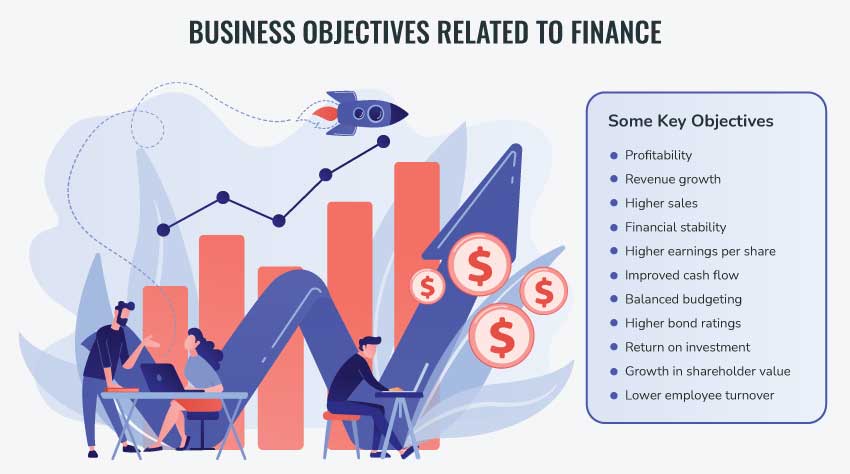
1. Maximizing profitability
In any industry and for all kinds of businesses, the maximization of profits will be the very first objective. Profitability is the top concern of businesses under their strategic plans for growth and advancement.
Key tip: Improving inventory management, initiating a hybrid work model, partnerships and acquisitions, product development strategies are some of the best ways to optimize profitability.
2. Expanding revenues
Augmentation of revenues is a quite obvious financial objective for businesses as revenue expansion is crucial for large profit margins.
Key tip: Devising effective strategies to sell in new markets, hiking the price of products, and taking the average transaction size to the upper side are some credible measures for increasing revenues.
3. Diversifying revenue streams
For companies looking to adopt aggressive strategies for revenue growth, one of the most promising objectives is to diversify their revenue streams to have multiple sources of profits. The above example of Tesla and SpaceX fits perfectly well here.
Key tip: Working on a concentric diversification plan to create products similar to the existing products with the existing resources is among the smartest approaches to product diversification.
4. Achieving financial stability
Achieving financial stability for times of uncertainties like the COVID-19 pandemic and having enough working capital for unprecedented situations is an important financial objective.
Key tip: Maintaining a contingency working capital for a period of six months at least in case of an unprecedented financial crisis is something that is strongly recommended from the purview of financial stability.
5. Managing cost in an efficient way
Profitability to a large extent depends on the various costs that a business has to incur for several domains. The greater the costs the lesser the profit margins. Hence, effective management of costs of various kinds is a common objective among all organizations.
Key tip: Having a streamlined supply chain is one of the most important cost-cutting actions that businesses need to take into consideration.
6. Growing shareholder value
One of the top financial objectives that businesses have is to amplify the financial value for their stakeholders and owners. The stakeholders and owners should see their investments growing.
Key tip: Subtly increasing the price per unit and bringing down the unit cost substantially is one of the most meticulous measures for creating more value for shareholders.
7. Maintaining favorable bond ratings
Good bond ratings are testaments of financial wellness for companies and hence, maintaining favorable bond ratings is a pivotal objective for business organizations.
Key tip: Maintaining financial wellness and positive financial statements are some highly imperative parameters that attract favorable ratings from bond rating agencies like Moody’s and DBRS.
8. Augmenting earnings per share
The earnings per share speak for the financial strength of a business in the stock market as well as the entire corporate space. For growth and advancement, increasing earnings per share is an essential financial objective.
Key tip: Achieving an increase in net income is the most basic and actionable measure for augmenting earnings per share.
9. Getting high returns on investment
A company makes multidimensional investments across fixed capital, working capital, brand endorsements, mergers etcetera. The objective is always to drive high returns on such exorbitant investments.
Key tip: Running a thorough background check and applying a cause and effect relationship before making an investment is what can help a company achieve high returns.
10. Ensuring balanced budgeting
For financial prosperity, companies need to maintain a balance in their budgets at all times. In fact, it is one of the most fundamental financial objectives for any business.
Key tip: Hiring proficient and experienced bookkeepers and accounting consultants is what will be the best way for maintaining a balanced budget.
11. Improving cash flow management
Cash flow is a clear representation of how strong a company is financially and how well it performed in comparison to the last quarter or the last fiscal year. Given that, optimizing the management of cash flow is an objective most businesses commit to.
Key tip: Offering attractive discounts on early cash payments can be an innovative way to improve cash flow.
12. Minimizing employee turnover
As per Gallup, business ventures in the US collectively lose around USD 400 billion because of high employee turnover. Needless to say, every business would want to avoid such hefty and unwanted losses. Therefore, minimizing employee turnover is an objective, businesses are laying a lot of emphasis on.
Key tip: Offering special monetary incentives to employees on Christmas can be an outside-the-box idea to pull down employee turnover rates.
Business objectives related to marketing
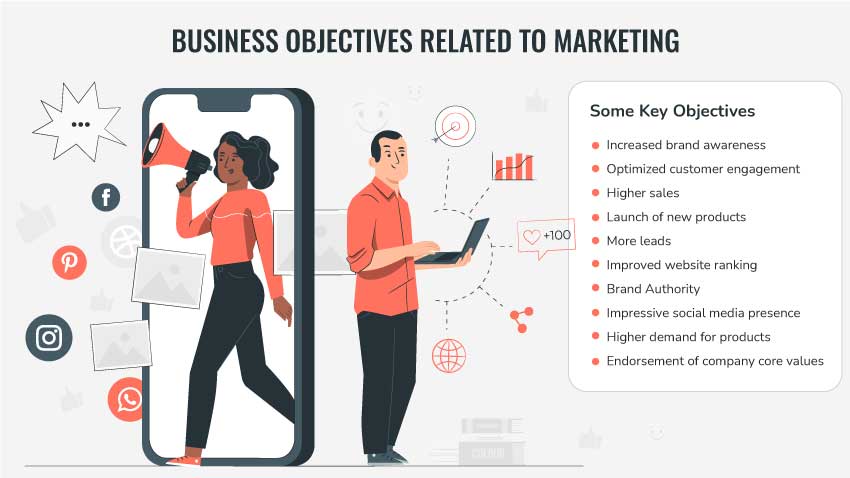
1. Increasing brand awareness
One of the most basic objectives around marketing is to increase brand awareness among potential customers and buyers. A brand’s growth becomes more feasible when more and more people discover the brand.
Key tip: Influencer marketing can be used to take a brand among new users and create greater brand awareness among new customer segments on social media platforms like Facebook and Instagram.
2. Boosting customer engagement
Increasing customer engagement on social media and through offline events is another important business objective linked to marketing. Customer engagement can be a vital way of influencing purchasing among customers.
Key tip: Inviting customers to the launch of new products and other mega celebrations can be a smart way in which companies can keep their customers involved and engaged.
3. Generating higher leads
Another pivotal business objective linked to marketing is to generate qualitative leads that have greater prospects of conversions. The higher the number of quality leads the greater will be the chances of prospects.
Key tip: A business can generate more leads by launching appealing customer referral programs for existing customers to increase the number of referrals.
4. Higher sales
The next business objective companies set for themselves after attaining promising leads is to convert those leads and drive higher sales. That is what the ultimate purpose of marketing is after all!
Key tip: Companies can offer exclusive discounts and special perks to existing customers to draw them into purchasing new products and services.
5. Gaining greater market share
One important objective linked to marketing is to attract more customers and hence increase the market share of a business in an existing market. An increased market share will be a direct indicator of business advancement.
Key tip: Companies can run affiliate paid ads to target potential customers from a particular age group or location to increase their market share by winning new customers.
6. Maximizing return on investment
In the modern corporate world, businesses are shifting from traditional marketing strategies to digital marketing strategies. As a part of digital marketing strategies, one of the pivotal objectives is to get a high return on investments made on paid ads, PPC, SEO, SEM, and other forms of digital marketing.
Key tip: Using a structured framework of keywords, using time-sensitive ads, and creating customized landing pages are some of the best practices for increasing ROI on PPC campaigns.
7. Introducing products among new customer segments.
One significant objective that companies set in alignment with their marketing tactics is to create a buzz around the introduction of products among new customer segments to increase sales.
Key tip: Carrying out extensive research on the product search patterns of millennials and Gen Y people on social media and browsers can help a great deal in meeting this marketing objective.
8. Expressing company core values
Marketing campaigns are often designed while keeping company core values at the forefront of things and endorsing strong virtues to attract customers. So, to include company core values in marketing campaigns in a common business objective.
Key tip: Creating ads that boast the core values of the company and can establish an emotional connection with the target audience is what can make a marketing campaign highly successful.
9. Reinforcing brand authority
Given the colossal competition and high customer attrition in every industry, brands need to reinforce their authority. Hence, setting the objective of increasing brand authority is a part of successful marketing.
Key tip: Hosting regular webinars and offline events and marketing them aggressively is one worthwhile way of establishing brand authority.
10. Improving website visibility in search engine results
As a part of digital marketing strategies adopted by businesses, one of the most vital objectives is to enhance the visibility of their official websites for generating more leads from search engine queries around relevant keywords.
Key tip: Using compelling and SEO-friendly meta titles and meta descriptions based on relevant keywords is a pro tip for increasing website traffic and visibility. Also, getting more backlinks to the website is one great way of meeting this objective.
11. Launching a new product or service
Launching new products and services and taking these among a vast audience of potential customers online and offline is an important business objective coherent to marketing.
Key tip: Streaming the launch of new products live from official social media handles can be an intriguing way in which companies can market their products in a way such that they become the center of attraction right from their launch.
12. Creating high demand for a product or service
A smart business objective in the vertical of marketing is to create a high demand for a product by making potential customers believe that a product or service can change their lives for the better.
Key tip: Companies can leverage user-generated content and create high demand through the positive experiences of customers shared from the medium of user-generated content. In another way, companies can make customers market their products to new customers on behalf of the company.
13. Connecting with the emotions of potential customers
Leveraging storytelling marketing to connect with the emotions and feelings of customers and then drawing them to make buying decisions is one of the most innovative business objectives from the viewpoint of marketing.
Key tip: Businesses can rope in popular celebrities, role models, or sports stars to narrate compelling stories around their brands to trigger the emotions of the target audience and create a relatability factor.
14. Creating a strong social media presence
The expanse and scope for social media marketing are increasing at a rampant pace as many shoppers use social media to search for new products and services. As more and more companies are realizing this, they are vouching for a greater social media presence.
Key tip: Using hashtags, compelling captions, IGTV videos and engaging stories are some of the most powerful marketing tools for building a charming brand presence on social media.
Business objectives pertaining to sustainability
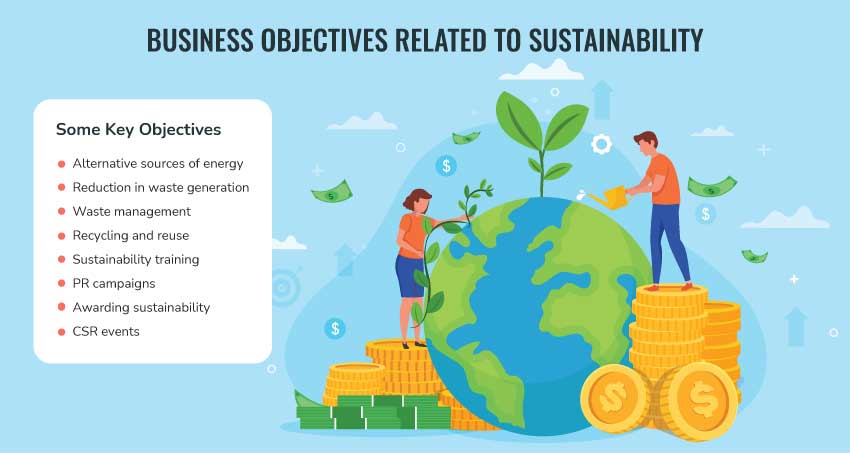
1. Investing in alternative sources of energy
From the purview of sustainability, it becomes essential that businesses adopt an aggressive approach towards carrying out R&D and developing alternative sources of clean energy.
Key tip: Companies can sponsor various research projects undertaken by research institutes and universities to fast-track the development of clear sources of energy.
2. Minimizing waste generation
Reduction in waste generation to deliver on sustainability commitments is a common example of business objectives set by companies incorporating sustainable practices.
Key tip: Business organizations can effectively reduce their waste generation by reducing packaging and going completely paperless which is more than feasible in this digital age.
3. Improving waste management
Besides setting the objective of reducing waste generation, companies also set objectives for improving the management of the waste produced in various processes.
Key tip: Linking waste management to the material management policies of the organization can be an impressive measure to achieve this objective.
4. Boosting recycling and reuse
Another important objective from the viewpoint of sustainability is to adopt the practices of recycling and reuse as a part of sustainable business policies.
Key tip: Renting tools and some items that are not a part of everyday operations can be a more sustainable approach than buying them. This can be a valuable practice in the direction of recycling and reuse.
5. Promoting unconventional production processes
A key business objective under sustainability commitments is to promote unconventional production processes that give high outputs at reduced energy consumption requirements. The key is to explore processes that are more sustainable and efficient than traditional production processes.
Key tip: Running trials of novel and unconventional practices at small levels before their complete incorporation into the production process will be a smart approach.
6. Developing alternatives to plastic packaging
Plastics are among the leading contaminants of the planet and hence one of the business objectives coherent with sustainability is to develop alternatives to plastic packaging.
Key tip: Plant-based plastics are emerging as reliable alternatives to conventional packaging and companies can look at the scope of R&D in plant-based plastics to meet their sustainability objectives.
7. Training employees on sustainability
The incorporation of sustainable business practices will be the most effective when the top management shares its vision on sustainability with all employees and trains them for working around sustainable practices.
Key tip: Holding interactive and fun-oriented events in the workplace based on the discussions around energy management can be an engaging way of training employees for sustainability.
8. Designing PR campaigns on sustainability
It is also imperative to create hype around the sustainable policies of a company to attract the media and customers who have an inclination towards businesses with strong values. Right from the logo design to marketing ideas and promotional tactics,everything should directly cater to the main business objective. Hence, designing strong PR campaigns on sustainability can be a great example of business objectives.
Key tip: Companies can run successful green PR campaigns by educating their consumers on sustainability and communicating their sustainable goals to consumers via indulging seminars and webinars.
9. Awarding sustainable behaviors
To keep employees inspired and motivated around the idea of sustainability, it becomes essential to award sustainable behaviors and present fine examples of a strong belief in sustainability in front of others.
Key tip: Having a well-defined reward structure with appealing perks for employees exhibiting sustainable behaviors can be a great way of motivating the entire workforce to embrace the idea of sustainability.
10. Sponsoring events linked to sustainability
Sponsoring or organizing events promoting the idea of sustainability is another example of business objectives set by companies to expand their outreach on the idea of sustainability. Tree plantation drives, marathons, walkathons are some common examples of such events.
Key tip: In coherence with their corporate social responsibility, companies can organize tree plantation drives and facilitate the same with strong public relations campaigns.
Business objectives related to innovation
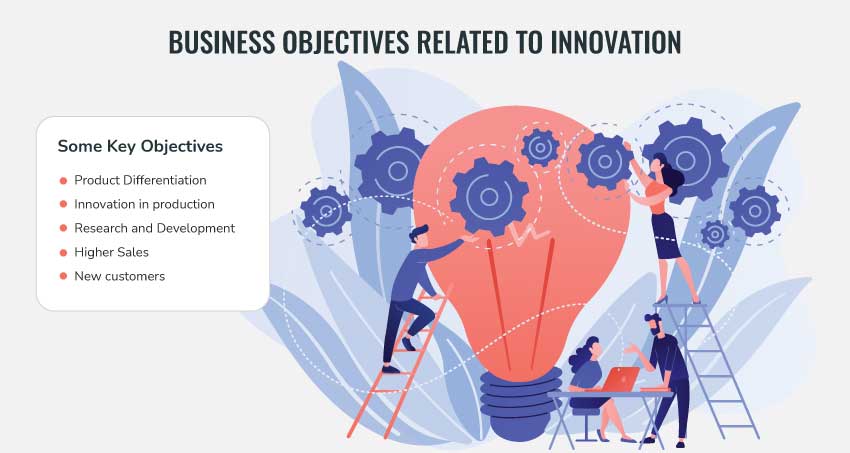
1. Achieving product differentiation through innovation
Product differentiation is a common strategic goal that businesses aim at for diversifying their profitability and mitigating risks. Under this strategic goal, achieving product differentiation through innovation is an objective that companies often undertake.
Key tip: Launching new product lines based on AI and IoT can be game-changing for companies in terms of diversification. Keeping innovation at the forefront of diversification holds the key to growth.
2. Offering the most innovative products to customers
There is massive competitiveness around innovation nowadays and we often see firms indulging in the race of offering the most innovative and advanced products to customers.
Key tip: Companies can use various surveys to understand customer preferences and the kind of innovation they look forward to with regard to products and services that are highly useful to them.
3. Allocating funds to R&D in innovation
Investing financial resources to facilitate the research and development of novel innovative resources and tools for boosting efficiency is an objective that businesses should undertake to be able to drive digital transformation.
Key tip: Allocating an adequate budget to R&D in innovation in consultation with the financial department can be a prudent idea to enhance the scope of innovation.
4. Winning new customers with innovative products
Launching new products in the market that are based on the state of the art technologies and powered by stellar technological innovation is an objective we often see companies pursuing.
Key tip: Companies can design strong marketing campaigns around the idea of how innovative products in their product portfolio can change the lives of customers for the better. The focus should be on targeting specific generations for which the products are designed.
5. Upscaling sales
Increasing sales of products and services with the help of innovative strategies for production, development, and company branding is among the significant objectives that businesses have.
Key tip: Companies can innovate and improvise on attractive EMI options, cashback offers, and other special discounts to attract new customers and hence boost sales.
Business objectives related to learning and development of employees
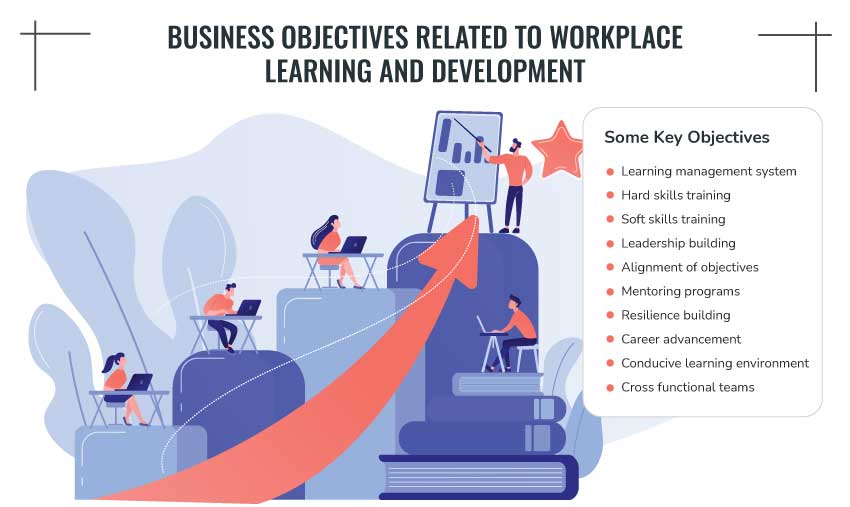
1. Investing in Learning Management System
Online learning and Learning Management Systems are changing the face of employee learning and development. Many organizations have already incorporated LMS and other companies too are looking forward to investing in LMS for reducing training and development costs.
Key tip: Companies can blend a majority of their training modules with a learning management system and employees can attend these training sessions online while being at home. In this way, companies can save on the costs of catering and logistics that go into training.
2. Optimizing technical skills/hard skills in employees
As rampant automation is taking place and the dependence on technology is increasing, the objective of upskilling the technical or hard skills of their employees has become vital for business ventures.
Key tip: Sponsoring employees to pursue online courses and certification programs in hard skills from top educational and learning apps can be a smart way in which companies can train their employees in hard skills without holding expensive physical training sessions.
3. Facilitating soft skills learning
Soft skills like communication skills, collaboration skills, and creativity are becoming increasingly desirable in the workplace. Companies are now paying great heed to the objective of assisting employees in learning soft skills.
Key tip: Soft skills can be made a part of on-job training where managers and leaders model crucial soft skills for others rather than holding seminars or soft skills and their relevance. Practical learning of soft skills will be more impactful in the context of this objective.
4. Investing in tools for remote learning and training
There is now a paradigm shift towards remote learning, development, and training. Given that, the objective of investing in the most appropriate and effective tools for learning and training becomes crucial for organizations.
Key tip: Comprehensive research needs to be carried out and the tools should be tested before investing in them as investing in the wrong tools can lead to mismanagement of objectives as well as financial losses.
5. Streamlining alignment of objectives
Companies cannot ignore the objective of having employees’ interests and actions aligned to company goals at all times. Hence, business firms lay a lot of emphasis on aligning the idea of employee learning and development to their strategic goals and plans.
Key tip: To ensure a better alignment between the learning objectives of employees and the strategic goals of the company, the top management should also promote a sense of belonging to boost allegiance among employees.
6. Boosting leadership capabilities in employees
Training employees to take up leadership roles in the future and building on their leadership qualities is a common example of business objectives these days.
Key tip: Creating leadership opportunities for employees and asking them to volunteer for leadership roles in different contexts can help in building leadership capabilities in a more practical way.
7. Building resilience in employees
It is the need of the hour that organizations build a resilient workforce to cope up with unprecedented challenges like the COVID-19 havoc. So, a lot of companies are now working on the objective of fostering resilience in their employees.
Key tip: Exposing employees to challenging situations and letting them deal with these situations in their own way can be an effective measure for building a resilient workforce.
8. Training employees on the latest working trends
Professional development has new dynamics in contemporary times as the corporate world has seen many new trends taking over. From the need for hybrid working cultures to the increasing significance of emotional intelligence in the workplace, companies set objectives for creating training modules corresponding to all the important developments in working cultures.
Key tip: The top management should discuss every latest development in the organization with employees and provide on-job training for the same.
9. Initiating mentoring programs in the organization
Beginning thoughtful mentoring programs to support employee learning and development is a meticulous objective that can help employees to benefit from the experience of their seniors. The likes of Google, Microsoft, and Accenture have some excellent mentoring programs to learn from.
Key tip: For better engagement and more conducive learning, companies can also initiate reverse mentoring programs wherein subordinates too can mentor their seniors on being tech-savvy and comfortable with digitalization.
10. Creating a conducive learning culture
One objective that all companies should set is to create a learning-friendly environment that captivates the curiosity and motivation of employees to add value to their professional outlook via incessant learning.
Key tip: To create a conducive learning culture, organizations should work on building an impression that they are dedicated to adding value to the development of their employees. The idea of learning and development should be presented as being more beneficial to employees than to a company.
11. Offering opportunities for career advancement
Organizations are now realizing that in the direction of employee learning and development for the larger good of the organization, they need to set an objective of providing proportionate career advancement opportunities to employees.
Key tip: A salary hike may not be feasible all the time when it comes to career advancement opportunities for employees. In such scenarios, companies offering better job titles to employees can be a good way to make employees believe that the organization is investing in their careers.
12. Constructing cross-functional teams
The objective of creating cross-functional teams is set within organizations to enable employees to gain practical learning experiences and work in a heterogeneous environment where people specialize in different skill sets and expertise.
Key tip: Trust is the basis of teamwork and coordination among cross-functional teams can be trickier. While creating cross-functional teams, the focus should be on a clear explanation of roles and responsibilities. Moreover, trust-building activities should be promoted among cross-functional teams.
Business objectives pertaining to performance management
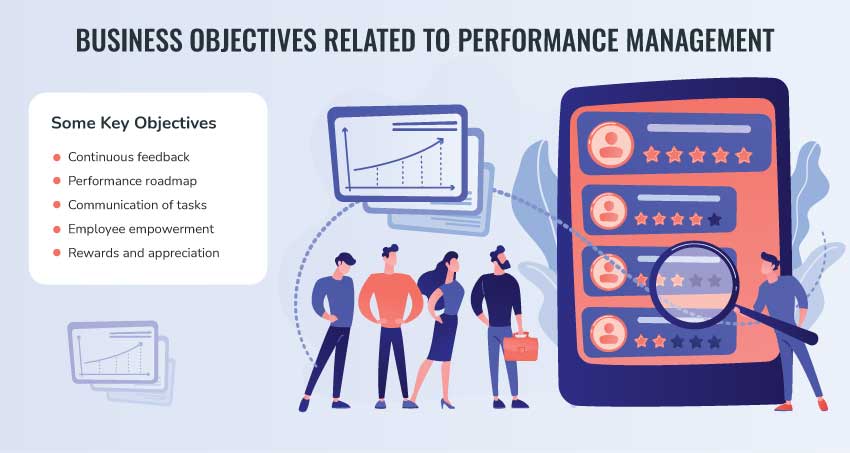
1. Creating continuous feedback mechanisms
As per HubSpot, 98 percent of employees tend to get disengaged in the absence of regular feedback. Given that, continuous feedback sharing is crucial for efficient performance management.
Key tip: Continuous feedback sharing does not have to be too extensive or elaborative. When feedback sharing happens daily or weekly, it is better to keep it down to one or two issues discussed in a concise manner.
2. Preparing a well-defined performance roadmap
To give a clear direction to performance management, it is quintessential to set the objective of preparing a well-defined roadmap that explains how better performances can be inspired and what kind of performances are anticipated.
Key tip: An innovative way to create a performance roadmap is to first prepare a rough draft and then discuss it with team members to seek their views and suggestions for refining it.
3. Communicating daily tasks with clarity
Setting daily goals for teams and communicating the same to them in an effective, transparent, and clear way is an indispensable objective to avoid performance lapses and project failures.
Key tip: While communicating daily tasks, key performance indicators should also be defined by top managers so that employees are aware of the metrics on which their performance will be evaluated.
4. Empowering employees by backing them
Empowering employees by showing greater trust in them, offering more flexibility to them, and giving them a fair share of autonomy is a business objective gaining greater popularity in this era of remote work.
Key tip: Delegating more authority and tasks to employees is a smart tactic for displaying greater trust in employees and giving them a sense of empowerment and self-sufficiency.
5. Rewarding exemplary performances
Extending rewards and recognition to those performing exceptionally well and setting fine examples for others is a worthwhile business objective.
Key tip: When employees receive recognition for setting standards of performance, appreciation should be extended to them in front of all employees so that it sets a benchmark for everyone else.
Business objectives related to production and operations
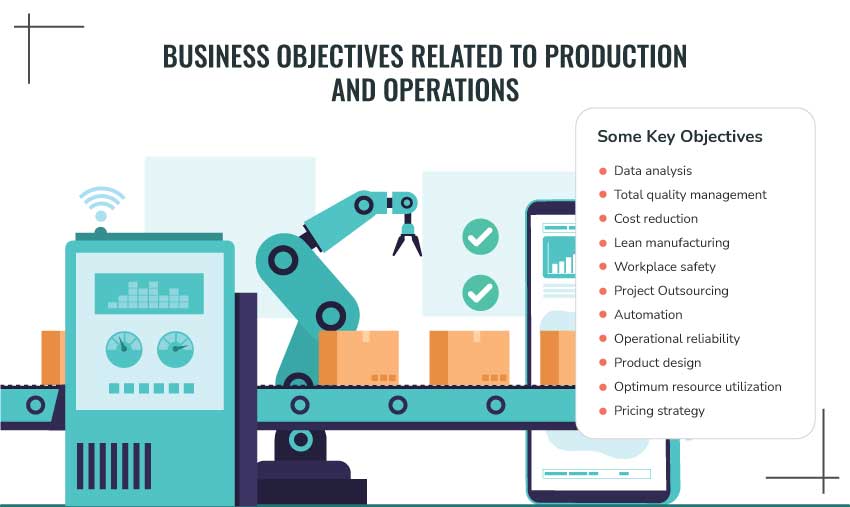
1. Data analysis
Using data related to customer patterns, previous quarter’s sales, the performance of products in the last fiscal year, production costs etcetera can be of great use to refine production processes and product designs.
Key tip: Companies can recruit expert data analysts to effectively collect the important data and evaluate it efficiently with the view of driving positive changes in operations and production.
2. Maintaining the highest quality of products
This objective is quite self-explanatory as every business is determined to produce goods of superlative qualities with the view of better market penetration and business growth.
Key tip: Firms can ensure the highest quality of products by testing their product in the market before the final launch. The product and market test will enable the firm to identify the shortcomings or quality issues in the product in case any of these exist.
3. Focusing on lean manufacturing
Lean manufacturing refers to the process of deriving maximum productivity out of production processes and minimizing the waste simultaneously. For sure, lean manufacturing is a smart business objective.
Key tip: Promoting greater efficiency in cross-functional communication via advanced tools can help companies a great deal to eliminate the unnecessary wastage of time between various manufacturing processes.
4. Keeping production costs low
While maintaining the highest quality of products is a priority objective for businesses, reducing production costs by bringing more efficiency in production is also among the top objectives.
Key tip: Production overhead costs can be cut down significantly by reducing the carrying cost of inventory. Besides, reviewing the manufacturing process on a regular basis to identify procedures that add no value to production and hence eliminating them is another smart tactic.
5. Incorporating customer preferences into product design
Bringing amendments in product designs according to changing customer preferences and on the basis of customer feedback is an important objective from the purview of production.
Key tip: Companies can look at more creative ways of receiving customer feedback on problems and solutions with regard to specific products. Besides, companies can also rely on surveys and polls to have customer ideas and preferences on the table while discussing product designs.
6. Adopting a competitive yet attractive pricing strategy
Production and pricing strategies are correlated with each other. It is crucial for businesses to adopt competitive pricing strategies while making sure that the pricing is also appealing to customers.
Key tip: Analyzing the average disposable income of the target customer segment and further analysis of the prices of competitors can be two meticulous tactics for developing a competitive pricing strategy.
7. Reducing operating costs annually
Business firms set the objectives for reducing their operating costs on a year-on-year basis so that the productivity of operations can be derived at lower costs leading to larger profit margins.
Key tip: Downsizing the office space and replacing monetary incentives for employees with non-monetary perks are two brilliant ideas for cutting down operational costs significantly. Offering more days of remote work to employees can also make valuable contributions to the objective of cost-cutting.
8. Focusing on total quality management
Total quality management checks and supervision are among the most crucial business objectives of any firm that does not compromise quality in any way. In fact, companies take this particular objective quite seriously.
Key tip: An effective integration of departments and different functionalities within an organization in a horizontal manner can help companies attain better outcomes in terms of total quality management.
9. Minimizing wastage of resources
One important objective for boosting the output and efficiency of operational processes is to minimize the waste of resources. The objectives are rather setting for utilizing the available resources to maximum capacity for positive business outcomes.
Key tip: This imperative objective can be met by companies in a more worthwhile way when they begin to keep overproduction in check. Overproduction leads to wastage of resources including monetary resources as well as materials.
10. Enhancing operational reliability
Another common business objective that companies set for themselves with regards to operational efficiency is to increase the reliability factor in operational processes. The greater the reliability of operations the better will be the coordination and output.
Key tip: Companies can have policies in place for regular audits of operational procedures to identify the performance gaps in operational efficiency and optimize operational reliability with problem-specific solutions.
11. Maintaining safety standards in the workplace
Businesses know that not providing a safe working environment to employees can be hazardous and can attract negative repercussions. Hence, maintaining high standards of workplace safety and rendering a hygienic working environment to employees is one of the most common examples of business objectives.
Key tip: Providing proper training to employees on handling workplace hazards and conducting mock drills linked to workplace accidents on a regular basis are promising solutions for maintaining safety standards. Moreover, using floor markings for areas that are sensitive to workplace accidents and disasters can further help the cause of the objective.
12. Implementing automated solutions
Automated solutions and other technological innovations are making operational processes far more efficient than ever before. Given that, amid the ongoing digital revolution, almost all businesses have set objectives around the automation of some operational processes.
Key tip: Companies can make imperative gains in their manufacturing efficiency with the implementation of ERP that enables extensive streamlining and automation in manufacturing.
13. Minimizing operational errors
Errors and efficiency cannot go hand in hand and hence, the minimization of operational errors has got to be on the list of business objectives of all organizations irrespective of domain or stature.
Key tip: Business organizations can incorporate automation into various operational procedures to reduce operational risks and errors. Moreover, managing the failure of equipment in an effective way is also a crucial measure that companies should take.
14. Outsourcing projects
Outsourcing of projects to cut back on operational costs and to have some projects done by experts outside the organization is quite a common example of business objectives relevant to operations.
Key tip: Organizations should create a pipeline of freelancers or rather create a network of freelancers across versatile expertise to be able to outsource their projects in a timely manner to meet project deadlines. As for manufacturing companies, they can outsource the manufacturing of some spare parts to smaller manufacturers.
To encapsulate, every strategic goal that any company envisages in terms of advancement and growth is further divided into a spectrum of specific and measurable objectives. As mentioned above, these objectives work the best for the goals of an organization when these objectives have a SMART perspective to them. What is interesting to understand is that the list of business objectives is inexhaustible as different industries and verticals will have different business objectives in different phases.
This can be deciphered taking into account the context of the unfortunate COVID-19 pandemic. There is a huge disconnect between the business objectives of organizations in the pre-COVID era and the post-COVID era. Objectives are subject to change when strategies and the external environment change. Having said that, having some flexibility around business objectives will be great. What do you think about that?


